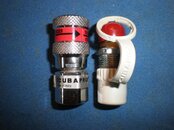mahjong
Contributor
And a special shout out to DAaquamaster as well!
Might anyone know if it is okay or not to use the old Scubapro HP quick-disconnect system, the one that attaches directly to the first-stage (not to the spg or computer), with an MK20 Ultra Light? Maybe it's a non-issue, but I do recall reading some warnings about being careful with the resin-coated aluminum (is it aluminum?) of the UL. Just wondering if anyone has any thoughts or experience.
I have used this HP quick disconnect for years with my MK10 and love it. I have a brand new one and would use this one with my MK20UL (packing for travel right now), so corrosion is not an issue.
Thank you!
Might anyone know if it is okay or not to use the old Scubapro HP quick-disconnect system, the one that attaches directly to the first-stage (not to the spg or computer), with an MK20 Ultra Light? Maybe it's a non-issue, but I do recall reading some warnings about being careful with the resin-coated aluminum (is it aluminum?) of the UL. Just wondering if anyone has any thoughts or experience.
I have used this HP quick disconnect for years with my MK10 and love it. I have a brand new one and would use this one with my MK20UL (packing for travel right now), so corrosion is not an issue.
Thank you!
Attachments
Last edited:





